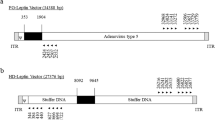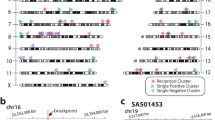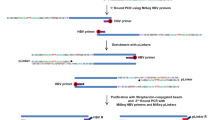Abstract
We have previously isolated from a human hepatocellular carcinoma a hepatitis B virus integration in a 147-base-pair cellular DNA fragment, similar to steroid- and c-erb- A/thyroid-hormone receptor genes1. We have now cloned the corresponding complementary DNA from a human-liver cDNA library. Nucleotide sequence analysis revealed that the overall structure of the cellular gene, which we have named hap, is similar to that of the DNA-binding hormone receptors. That is, it displays two highly conserved regions identified as the putative DNA-binding and hormone-binding domains of the c-erb A/steroid receptors2–9. Six out of seven hepatoma and hepatoma-derived cell-lines express a 2.5-kilobase (kb) hap messenger RNA species which is undetectable in normal adult and fetal livers but present in all non-hepatic tissues analysed. The data suggest that the hap gene product may be a novel ligand-responsive regulatory protein whose inappropriate expression in liver may relate to the hepatocellular carcinogenesis.
This is a preview of subscription content, access via your institution
Access options
Subscribe to this journal
Receive 51 print issues and online access
$199.00 per year
only $3.90 per issue
Buy this article
- Purchase on Springer Link
- Instant access to full article PDF
Prices may be subject to local taxes which are calculated during checkout
Similar content being viewed by others
References
1. Dejean, A., Bougueleret, L., Grzeschik, K. H. & Tiollais, P. Nature 322, 70-72 (1986). 2. Sap, J. et al. Nature 324, 635-640 (1986). 3. Weinberger, C. et al. Nature 324, 641-646 (1986). 4. Green, S. et al. Nature 320, 134-139 (1986). 5. Greene, G. L. et al. Science 231, 1150-1154 (1986). 6. Conneely, O. M. et al. Science 233, 767-770 (1986). 7. Kumar, V., Green, S., Staub, A. & Chambon, P. EMBO J. 5, 2231-2236 (1986). 8. Hollenberg, S. M., Giguere, V., Segui, P. & Evans, R. M. Cell 49, 39-46 (1987). 9. Miesfeld, R., Godowski, P. J., Maler, B. A. & Yamamoto, K. R. Science 236,423-427 (1987). 10. Hollenberg, S. M. et al. Nature 318, 635-641 (1985). 11. Miesfeld, R. et al. Cell 46, 389-399 (1986). 12. Loosfelt, H. et al. Proc. natn. Acad. Sci. U.S.A. 83, 9045-9049 (1986). 13. Krust, A. et al. EMBO J. 5, 891-897 (1986). 14. Giguere, V., Hollenberg, S. M., Rosenfeld, M. G. & Evans, R. M. Cell 46, 645-652 (1986). 15. Sonenberg, N., Guertin, D. & Cleveland, D. Cell 27, 563-572 (1981). 16. McGarry, T. J. & Lindquist, S. Cell 42, 903-911 (1985). 17. Jobling, S. A. & Gehrke, L. Nature 325, 622-625 (1987). 18. Yamamoto, K. R. A Rev. Genet. 19, 209-252 (1985). 19. Green, S. & Chambon, P. Nature 324, 615-617 (1986). 20. Kahn, P. et al. Cell 45, 349-356 (1986). 21. Gubler, U. & Hoffman, B. J. Gene 25, 263-269 (1983). 22. Sanger, F., Nicklen, S. & Coulson, A. R. Proc. natn. Acad. Sci. U.S.A. 74, 5463-5467 (1977). 23. Wilbur, W. J. & Lipman, D. J. Proc. natn. Acad. Sci. U.S.A. 80, 726-730 (1983).
Author information
Authors and Affiliations
Rights and permissions
About this article
Cite this article
de Thé, H., Marchio, A., Tiollais, P. et al. A novel steroid thyroid hormone receptor-related gene inappropriately expressed in human hepatocellular carcinoma. Nature 330, 667–670 (1987). https://doi.org/10.1038/330667a0
Received:
Accepted:
Issue Date:
DOI: https://doi.org/10.1038/330667a0
This article is cited by
-
The role of Zic transcription factors in regulating hindbrain retinoic acid signaling
BMC Developmental Biology (2013)
-
Flower color alteration in the liliaceous ornamental Tricyrtis sp. by RNA interference-mediated suppression of the chalcone synthase gene
Molecular Breeding (2012)
-
Update of research and management of hepatitis B
Journal of Gastroenterology (2006)
-
Identification of novel RARβ2 transcript variants with short 5′-UTRs in normal and cancerous breast epithelial cells
Oncogene (2005)
-
Molecular cytogenetic analyses of breakpoints in apparently balanced reciprocal translocations carried by phenotypically normal individuals
European Journal of Human Genetics (2005)
Comments
By submitting a comment you agree to abide by our Terms and Community Guidelines. If you find something abusive or that does not comply with our terms or guidelines please flag it as inappropriate.



